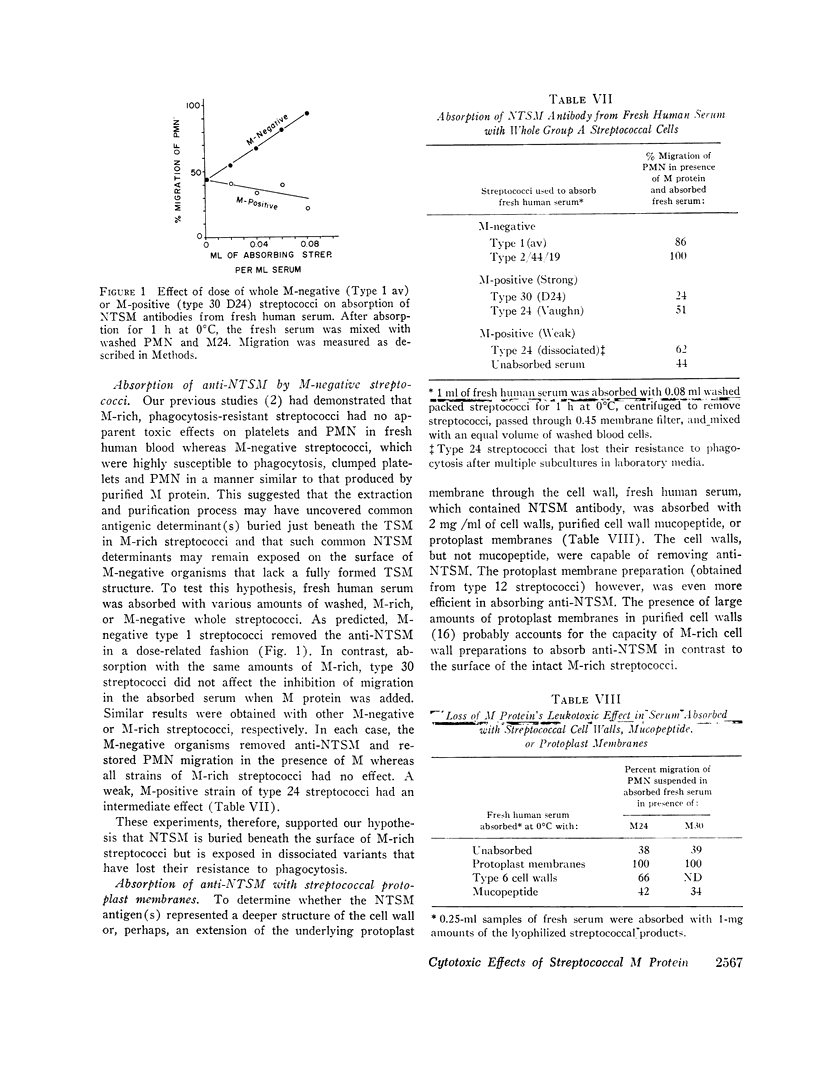Abstract
The cytotoxic moiety(ies) in highly purified streptococcal M protein has been shown to be distinct from the type-specific M determinant. This nontype-specific M-associated determinant(s) (NTSM) causes humoral and cellular immunotoxic responses in man. NTSM is common to M protein prepared from all streptococcal serotypes studied so far. In this study, immunoabsorbents prepared by entrapping purified M proteins in polyacrylamide gel were employed to identify, separate, and purify antibodies directed against NTSM as well as against the type-specific M (TSM) determinants.
We found that anti-NTSM present in human blood mediated cytotoxic platelet and leukocyte reactions in the presence of “M proteins” prepared from groups A, C, and G streptococci. Human sera that produced cytotoxic reactions and fixed complement in the presence of highly purified M protein but that contained no antibody to the homologous TSM determinant were used as a source of anti-NTSM. Anti-NTSM was absorbed with and eluted from M protein-polyacrylamide particles and identified as IgG. Antibodies to NTSM were present in most normal human sera and some primate sera (rhesus monkey and baboons) but not in the sera of other common laboratory animals. Further absorption studies showed NTSM to be a component not only of extractable M protein but also of protoplast membranes and of cell walls of avirulent streptococci that lacked extractable TSM antigen.
Preparation of antisera that can distinguish between the type-specific protective moiety and the closely associated immunotoxic components in purified M protein vaccines may help answer whether or not M-associated moieties play a role in pathogenesis of poststreptococcal diseases.
Full text
PDF







Images in this article
Selected References
These references are in PubMed. This may not be the complete list of references from this article.
- Abdulla E. M., Schwab J. H. Biological properties of streptococcal cell-wall particles. 3. Dermonecrotic reaction to cell-wall mucopeptides. J Bacteriol. 1966 Jan;91(1):374–383. doi: 10.1128/jb.91.1.374-383.1966. [DOI] [PMC free article] [PubMed] [Google Scholar]
- BLEIWEIS A. S., KARAKAWA W. W., KRAUSE R. M. IMPROVED TECHNIQUE FOR THE PREPARATION OF STREPTOCOCCAL CELL WALLS. J Bacteriol. 1964 Oct;88:1198–1200. doi: 10.1128/jb.88.4.1198-1200.1964. [DOI] [PMC free article] [PubMed] [Google Scholar]
- BORN G. V. Aggregation of blood platelets by adenosine diphosphate and its reversal. Nature. 1962 Jun 9;194:927–929. doi: 10.1038/194927b0. [DOI] [PubMed] [Google Scholar]
- Beachey E. H., Alberti H., Stollerman G. H. Delayed hypersensitivity to purified streptococcal m protein in guinea pigs and in man. J Immunol. 1969 Jan;102(1):42–52. [PubMed] [Google Scholar]
- Beachey E. H., Stollerman G. H. The common antigen(s) of streptococcal M protein vaccines causing hyperimmune reactions in man. Trans Assoc Am Physicians. 1972;85:212–221. [PubMed] [Google Scholar]
- Beachey E. H., Stollerman G. H. Toxic effects of streptococcal M protein on platelets and polymorphonuclear leukocytes in human blood. J Exp Med. 1971 Aug 1;134(2):351–365. doi: 10.1084/jem.134.2.351. [DOI] [PMC free article] [PubMed] [Google Scholar]
- Bryant R. E., DesPrez R. M., VanWay M. H., Rogers D. E. Studies on human leukocyte motility. I. Effects of alterations in pH, electrolyte concentration, and phagocytosis on leukocyte migration, adhesiveness, and aggregation. J Exp Med. 1966 Sep 1;124(3):483–499. doi: 10.1084/jem.124.3.483. [DOI] [PMC free article] [PubMed] [Google Scholar]
- Carrel S., Barandun S. Protein-containing polyacrylamide gels: their use as immunoadsorbents of high capacity. Immunochemistry. 1971 Jan;8(1):39–48. doi: 10.1016/0019-2791(71)90420-4. [DOI] [PubMed] [Google Scholar]
- Fox E. N., Wittner M. K. Antigenicity of the M proteins of group A hemolytic streptococci. IV. Cross-reactivity between serotypes. J Immunol. 1968 Jan;100(1):39–45. [PubMed] [Google Scholar]
- Fox E. N., Wittner M. K., Dorfman A. Antigenicity of the M proteins of group A hemolytic streptococci. 3. Antibody responses and cutaneous hypersensitivity in humans. J Exp Med. 1966 Dec 1;124(6):1135–1151. doi: 10.1084/jem.124.6.1135. [DOI] [PMC free article] [PubMed] [Google Scholar]
- Jones J. M., Schwab J. H. Effects of streptococcal cell wall fragments on phagocytosis and tissue culture cells. Infect Immun. 1970 Mar;1(3):232–242. doi: 10.1128/iai.1.3.232-242.1970. [DOI] [PMC free article] [PubMed] [Google Scholar]
- Kaplan M. H. Cross-reaction of group A streptococci and heart tissue: varying serologic specificity of cross-reactive antisera and relation to carrier-hapten specificity. Transplant Proc. 1969 Dec;1(4):976–980. [PubMed] [Google Scholar]
- LANCEFIELD R. C. Current knowledge of type-specific M antigens of group A streptococci. J Immunol. 1962 Sep;89:307–313. [PubMed] [Google Scholar]
- Raskovă H., Rýc M., Rotta J., Masek K. Release of 5-hydroxytryptamine and morphological changes in blood platelets induced by mucopeptide of streptococcal cell walls. J Infect Dis. 1971 Jun;123(6):587–594. doi: 10.1093/infdis/123.6.587. [DOI] [PubMed] [Google Scholar]
- Rotta J., Bednár B. Biological properties of cell wall mucopeptide of hemolytic streptococci. J Exp Med. 1969 Jul 1;130(1):31–47. doi: 10.1084/jem.130.1.31. [DOI] [PMC free article] [PubMed] [Google Scholar]
- STOLLERMAN G. H., EKSTEDT R. D., COHEN I. R. NATURAL RESISTANCE OF GERM-FREE MICE AND COLOSTRUM-DEPRIVED PIGLETS TO GROUP A STREPTOCOCCI. J Immunol. 1965 Jul;95:131–140. [PubMed] [Google Scholar]
- Swanson J., Hsu K. C., Gotschlich E. C. Electron microscopic studies on streptococci. I. M antigen. J Exp Med. 1969 Nov 1;130(5):1063–1091. doi: 10.1084/jem.130.5.1063. [DOI] [PMC free article] [PubMed] [Google Scholar]
- Vosti K. L., Johnson R. H., Dillon M. F. Further characterization of purified fractions of M protein from a strain of group A, type 12 Streptococcus. J Immunol. 1971 Jul;107(1):104–114. [PubMed] [Google Scholar]
- Widdowson J. P., Maxted W. R., Pinney A. M. An M-associated protein antigen (MAP) of group A streptococci. J Hyg (Lond) 1971 Dec;69(4):553–564. doi: 10.1017/s0022172400021823. [DOI] [PMC free article] [PubMed] [Google Scholar]
- Wittner M. K., Fox E. N. Micro complement fixation assay for type-specific group A streptococcal antibody. Infect Immun. 1971 Oct;4(4):441–445. doi: 10.1128/iai.4.4.441-445.1971. [DOI] [PMC free article] [PubMed] [Google Scholar]
- Zabriskie J. B., Freimer E. H. An immunological relationship between the group. A streptococcus and mammalian muscle. J Exp Med. 1966 Oct 1;124(4):661–678. doi: 10.1084/jem.124.4.661. [DOI] [PMC free article] [PubMed] [Google Scholar]
- Zabriskie J. B. The relationship of streptococcal cross-reactive antigens to rheumatic fever. Transplant Proc. 1969 Dec;1(4):968–975. [PubMed] [Google Scholar]



